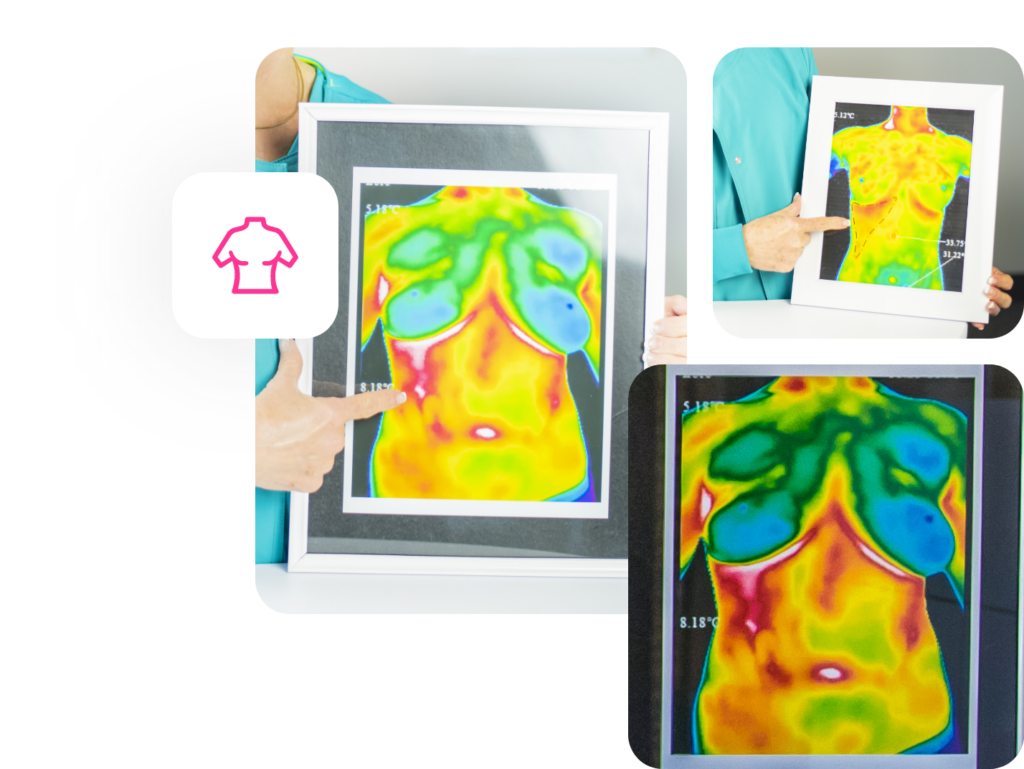
Services
Breast Thermography for Women & Men
Breast Thermography is invaluable screening for men and women alike, providing early indications of breast health risks, including cancer.
Using infrared screening tools, we can detect variations and irregularities in temperature and heat patterns throughout breast tissue, which may suggest certain abnormalities such as inflammation or tumor growth.

Overview Breakdown
Breast Thermography
It’s non-invasive, radiation-free, and doesn’t involve any potentially harmful chest compression typical of other mainstream screening methods, making it as comfortable as it is safe for regular and ongoing monitoring.
While breast cancer is less common in men than in women, men can still get it, making breast thermography just as useful a tool for early detection and monitoring for men as it is for women.
As with all medical procedures, it may be adjusted based on your health history and concerns. Consult your Certified Clinical Thermographer (CCT) for any specific questions relating to your specific circumstances.

We follow a step-by-step process to ensure you receive the best care and results for your scans:
01
Intake Forms and Symptom Survey
Upon arrival, you will fill out intake forms and a symptom survey. This includes details about your past surgeries, current symptoms, any areas of discomfort, and so on.
02
Consultation
After completing the forms, we sit down with you to discuss your symptom survey in depth. This consultation is a crucial part of the process as it allows us to thoroughly explore your medical history, understand your current symptoms, and answer any questions you may have about thermography. For many clients, their knowledge of thermography may be limited or they may have learned about it through social media platforms like TikTok, so we take the time to educate you about the process and its benefits.
03
Initial Scan Process
As Certified Clinical Thermographers (CCT), our role is akin to that of an x-ray technician in conventional medicine. We perform the thermal imaging scans, then send the images to Dr. Gregory Melvin, our Board Certified Clinical Thermologist. He reads and analyzes the images and then creates a detailed report of findings.
04
Post-Scan Plan
Once Dr. Melvin has interpreted the results, we discuss the findings with you and address any acute issues. From there, we come up with a plan for future scans and interventions based on these findings.
05
Follow-Up Scans (Recall)
After the initial scan, we typically recommend follow-up scans to track the client’s progress and changes in their thermal patterns. These usually occur three months, six months, and 12 months after the initial scan. The goal of these follow-up scans is to compare the results with the baseline obtained during the initial visit, and ensure everything is moving in the right direction. Finally, we advise yearly scans for ongoing monitoring and proactive health care.
Breast Thermography
Thermography Statistics
- Thermography is more accurate at distinguishing benign from malignant cases, with 92.70% accuracy compared to mammography’s 82.05%.
- Research indicates that combining breast thermography and structural imaging leads to improved survival rates.
- The American Cancer Society states that when breast cancer is found in the early stages and is localized, the 5-year survival rate is 99%.
- Approximately 42,000 women and 500 men in the U.S. die each year from breast cancer.
- 1 in 8 women in the United States will be diagnosed with breast cancer in her lifetime.

Select The Scan That’s Right For You
Full-Body Scan
Our full body scan is our most popular scan and our most comprehensive study; the most complete medical scan available.
- Varicosity
- Phlebitis
- Plantar fasciitis
- Circulatory and nerve damage related issues
- Neuropathy
- Pancreatic issues
- Pre-diabetic developments
- Everything included in the Half-Body Scan
- Everything included in the Breast Screening Scan
- … and so much more
Half-Body Scan
Top of the head to the pubic bone. Includes 19 images.
- Full cranial
- Deep-rooted periodontal issues (often missed on dental x-rays)
- Comprehensive thyroid
- Carotid artery
- Coronary issues
- Complete breast scan (note breast scan details)
- Lymphatic congestion and lymph node activity above the clavicle and under the arms
- Full spine (upper and lower back)
- Major organs: stomach, diaphragm, gallbladder, liver, large and small intestines, kidneys, ascending and descending colon, ovaries, uterus, bladder, etc.
- Intestinal inflammation
- … and more
Breast Thermography
Thermography FAQs
Mammograms are X-rays of the breast to search for lumps that could be signs of cancer. But they use radiation, which has some risks, and can sometimes even lead to unnecessary treatments or mastectomies. Plus, the process can be uncomfortable due to compression of the chest, potentially causing issues itself.
Breast Thermography is a breast cancer screening that analyzes heat from the breast tissue and instead checks blood flow and inflammation as opposed to only identifying lumps. This can show potentially major health issues long before they present as a physical lump. As a result, thermography doesn’t use radiation, so it’s safer from risks that are typical with mainstream scanning modalities. It’s also painless, not requiring any sort of chest compression. Thermorgraphy is known to spot potential problems as early as 2 years into a cancer’s development which normally isn’t noticed or symptomatic until much later.
After the initial visit, we typically recommend follow-up scans (recall scans) to track the client’s progress and changes in their thermal patterns. These usually occur three months, six months, and 12 months after the initial scan. The goal of these follow-up scans is to compare the results with the baseline obtained during the initial visit, and ensure everything is moving in the right direction. Finally, we advise yearly scans for ongoing monitoring and proactive health care.
Thermal imaging has been a Food and Drug Administration (FDA) approved medical imaging technique since 1982. Thermography offers a unique perspective on the body’s functioning by examining heat emissions to detect potential abnormalities. It supports the notion that the human body possesses inherent healing capabilities, and by monitoring thermal variations, thermography helps assess the body’s health status.
Although it is FDA-approved, thermography is not considered a replacement for mammograms or other conventional modalities, and is seen as more of a preventative measure, and is typically not covered by health insurances.
